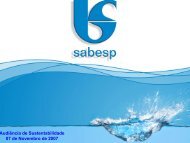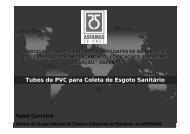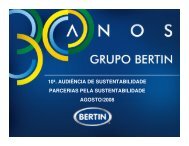Sustainability r e p o r t - Sabesp
Sustainability r e p o r t - Sabesp
Sustainability r e p o r t - Sabesp
You also want an ePaper? Increase the reach of your titles
YUMPU automatically turns print PDFs into web optimized ePapers that Google loves.
One of the topicsdiscussed in committeesand subcommittees is thewatersheds protection lawCorporate Program for the Regularization ofWater Resources Use PermitsThe program estimates the companywide regularization of the use permits, includingregulating dams, level increasing dams, river intakes, wells, and discharges ofexisting effluents. The ongoing program focuses on the High Tietê water resourcesmanagement units (UGRHIs), comprising the isolated systems of the São Paulometropolitan area. Another work front comprises the Vale do Paraíba, North Shoreand Mantiqueira UGRHIs. The Piracicaba/Capivari/Jundiaí and Santos LowlandsUGRHIs were included in contracts prior to 2008. The contracts for studies related tothe other UGRHIs are at their completion stage, and will complete regularization inthe State, scheduled to be completed by eh end of 2011. Permits for new projectsare being obtained during the building stage.Participation in Water Business CommitteesCurrently, approximately 150 SABESP employees participate directly in two federalcommittees, 21 state committees, and 5 statewide subcommittees. To managethis representation we created corporate guidelines to appoint our representativesand the performance of their activity. We also promoted events and meetingsto interchange information, leveling the knowledge and guidance for corporatealignment of our Business Units’ representatives. In the first half of2009, we replaced the members of the committees for the 2009-2011 term.We are also members of the National Water Resources Council(CNRH), by filling seats of the National Association of State Water& Waste Utilities (AESBE) and two technical panels. Our employees have an activeinvolvement in the seven technical panels of the State Water Resources Council(CRH), as representatives of the State Department of Sanitation and Energy (SSE).We participate in the plenary session of this Council as representatives of Aesbe.Follow-up of Collections for Water UseWe created a workgroup in March 2009 to follow up the collection process for the useof water resources. The workgroup has representatives from the Operating, Legal,Finance, and Integrated Planning functions and is coordinated by the EnvironmentalManagement function. We prepared guidance to establish the general guidelines andprinciples for the actions of the representatives at the committees, especially ontopics such as implementation of collection and the collection of these funds for useis new projects.In addition to the Paraíba do Sul and Piracicaba, Capivari and Jundiaí river basins,where we already pay for the use of water, we are implementing collection in theSorocaba and Mid Tietê basins. In December 2009, we approved proposals forcollection in four other basins in the State, as follows: Low Tietê, starting 2010, andHigh Tietê, Santos Lowlands, and Tietê–Jacaré, starting 2011.Classification of the Bodies of WaterWe are preparing the tender notice for the engagement of consulting services tostudy and assess the classification of the bodies of water, using quality modeling toolsand their application to a pilot basin. This study will permit assessing the impacts ofthe classification process and, based on the Juqueri river pilot hydrographic basin,located in the Far North of the São Paulo Metropolitan area, define an methodologyto be used in the other basins. This work will also provide inputs for our participationin the hydrographic basin committees during the classification process, which willrevise the current classification, dated 1977 (State Decree 10755/77).We conducted two seminars on the classification of the bodies of water as part ofa project called “Environmental Management Conferences Cycle”, addressed below.Representatives from different segments of society participated in these conferences,such as representatives of basin committees, municipal governments, universities,public prosecution office, non-governmental organizations, licensing agencies, andsubject matter experts.<strong>Sabesp</strong> Environmental Education Program (PEA)We conduct environmental and sanitation education activities for more than 20 yearsand, therefore, they are already part of our values, used in system operations andcommunication processes. However, since the enactment of Federal Law 9795/99,which creates the National Environmental Education Policy, and more recently theenactment of State Law 12780/07, which creates the São Paulo State EnvironmentalEducation Policy, we took environmental education as a key issue of our activities,together with the sanitation, water resources and environmental policies.96 Relatório de Sustentabilidade 2009 97



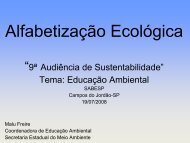
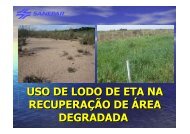
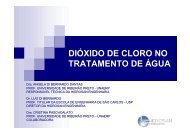
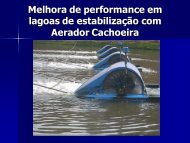
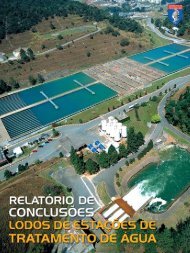
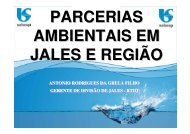
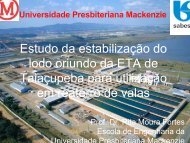
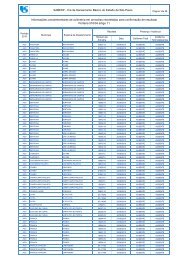
![MBBR ppt for Pulp&Paper, Sabesp, Oct 3, 2008 [Somente leitura]](https://img.yumpu.com/34976291/1/190x135/mbbr-ppt-for-pulppaper-sabesp-oct-3-2008-somente-leitura.jpg?quality=85)
